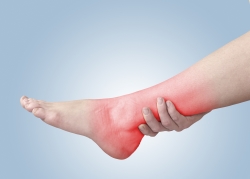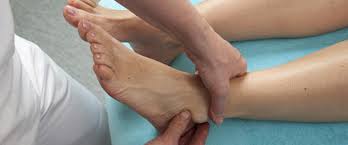
If you’ve recently had ankle surgery or are dealing with an ankle injury, getting around can feel frustrating.
That’s where a knee scooter makes all the difference.
Unlike crutches or walkers that often feel awkward and tiring, a knee scooter lets you move smoothly while keeping all the weight off your injured ankle, so you can still feel independent and comfortable.
A knee scooter is a lightweight, wheeled device with a padded platform where you rest your injured leg while using the other to glide forward.
Over time, it has evolved into a compact, foldable, and easy-to-use aid that fits seamlessly into daily life—whether at home, outside, or even at work.
Doctors often recommend knee scooters after ankle surgery, fractures, sprains, Achilles tendon injuries, or foot ulcers.
They’re also useful when waiting for a prosthetic fitting after partial foot amputation or during recovery from wounds in the ankle or heel. In short, it’s designed to give you freedom of movement at a time when walking normally isn’t possible.
Instead of struggling with crutches and feeling restricted, a knee scooter allows you to focus on healing while still living life on your terms. It’s not just a mobility aid—it’s a simple way to get your independence back while your ankle recovers.
Advantages of a Knee Scooter after an Ankle Injury
Using a knee scooter after an ankle injury or for a broken foot can make recovery far more comfortable and safe. Especially if you choose to pick a high-quality product from a top brand like Drive Medical.
Right after surgery, moving around feels difficult and even risky, as one wrong step or slip could hurt the healing ankle and delay recovery.
While you can rely on others for help at times, it’s not always possible to have assistance every moment. A knee scooter bridges that gap by giving you independence and peace of mind.
Here are five big advantages:
- Greater Safety – Unlike crutches or walking canes, which can make you wobble or slip, a knee scooter provides stability and lowers the risk of accidental falls.
- More Comfort – Instead of putting strain on your arms and shoulders like with crutches, you simply rest your knee on a padded platform and glide smoothly.
- Independence – You don’t have to wait for someone to help you move around. The scooter lets you get things done on your own, anytime.
- Faster Mobility – It’s easier to move longer distances quickly without the tiring effort crutches demand.
- Better Recovery Experience – Since you’re not constantly struggling with discomfort or fear of falling, you can focus on healing and maintain a more positive outlook during recovery.
In short, a knee scooter makes life after ankle surgery not just manageable but much less stressful—helping you move freely, safely, and with confidence.
A Few Drawbacks You Need to Know About
Although knee scooters offer you varied advantages, there are a few limitations you need to be aware of. Some of these include:
1- Not suitable for stairs – The major drawback of using a knee walker or a scooter is that it cannot be used for climbing stairs or coming down from them.
It’s designed in such a way that you can only use them on a flat surface or in an elevator, but not on stairs. If you try to use them on stairs, it might result in an accident and should, therefore, be completely avoided.
2- Puts more stress on the other foot – The design of a scooter requires you to walk using your healthy foot when you want to navigate from one place to another.
Since you are using your other foot for moving your body forward all the time, it can put extreme pressure and a lot of strain on your leg.
While a shorter distance would not be a problem, staying on a scooter for a longer time to cover long distances can be stressful due to constant kicking on the ground.
3- Requires balancing and poses a risk of falling – Walking on a knee scooter in a well-balanced way may require lots of practice and time. One wrong kick, and you may find yourself on the ground.
Since your injured leg remains on the crutch pad in an upright position and the other leg is constantly kicking on the ground to push the body forward, you will need to balance your body very well to avoid a fall.
Problems may get even worse for you if you get any new injuries. So, be careful and judge carefully whether you are the right candidate to use a scooter or not before trying it.
Can I Use a Knee Scooter While Wearing a Walking Boot?
Yes—you can absolutely use both together, and in fact, many doctors recommend it.
After ankle fracture surgery, patients are usually fitted with a walking boot (also called an orthopedic boot or CAM boot) to protect and stabilize the healing bones and soft tissues. At the same time, you’re often told to keep weight completely off that leg for several weeks.
This is where a knee scooter comes in: it allows you to stay mobile without putting any pressure on the healing ankle, while the boot continues to support and shield it.
Here’s how they work together:
- Boot for protection – The boot holds your ankle in the right position, reduces strain, and protects the surgical site during recovery.
- Knee scooter for mobility – The scooter gives you a safe way to move around without bearing weight, avoiding the instability and arm strain of crutches.
- Combined benefit – Wearing the boot while using the scooter adds an extra layer of safety. Even if you accidentally touch your foot down or bump it, the boot protects the ankle from sudden stress.
How to Use a Knee Scooter after Ankle Surgery? Important Safety Tips
Using a top-quality knee scooter (like KneeRover) after ankle surgery is simple once you get the hang of it.
- Place your injured leg’s knee on the padded cushion with the knee slightly bent so your shin rests comfortably.
- Keep your healthy foot flat on the ground—this foot will be used to push and propel you forward.
- Adjust the handlebars to a comfortable height so you can maintain balance and steer easily.
- While moving, always keep both hands on the handbars. Use the handlebars to guide direction while keeping both hands on them for stability.
- Maintain a good balance in the center by keeping all the wheels in proper control.
- Start moving slowly indoors to get comfortable, then use it outdoors on smooth pavements or grass with care.
- Squeeze the hand brakes gently when you need to slow down or stop. Avoid using the brakes frequently. Try to stop the scooter mostly by your unaffected limb, as it will help you to analyze the necessity and intensity of braking.
With these simple steps, you can move around safely, independently, and with much less effort during your ankle recovery.
However, the most important concern in using the knee scooter is falling. Falls will create unnecessary complications for the person who has undergone ankle surgery. Hence, the following things should be considered before using a knee scooter.
- Be sure that the height of the ankle scooter is appropriately adjusted and fixed. Also, the pins, bolts, clamps, and nuts should be securely arranged.
- Avoid climbing up or descending from the steps, stairs, or escalators. Keep a distance from the stairs.
- In case you need to carry some simple materials along with you while moving from one place to another, like books, phones, purses, etc., try to purchase a basket and fit in front of the scooter.
- Always wear non-slip footwear while using the knee scooter. And don’t carry another person or kids with you while you are moving on the knee scooter.
Tips for Choosing the Best Knee Scooter for A Broken Foot that Helps in Faster Recovery
When it comes to recovery after ankle or foot surgery, the right knee scooter can make a world of difference.
Choosing the right one isn’t just about comfort—it’s about safety, independence, and a faster healing process. Here are a few things to keep in mind:
Pick the right size for your body – Knee scooters come in different heights and weight capacities. Make sure you choose one that matches your height and can comfortably bear your body weight. If in doubt, a heavy-duty option is always safer and more durable.
Go for four wheels, not two – A four-wheeled knee scooter provides better balance and stability, which is especially important for avoiding falls during recovery. It’s a secure choice for people of all age groups.
Choose a strong build – Metal-framed scooters are far more durable and reliable compared to fiber ones. Since you’ll be using it daily, investing in a sturdy, long-lasting scooter ensures both safety and peace of mind.
Look for practical add-ons – A basket may sound like a small thing, but it’s incredibly useful. Whether indoors or outdoors, it lets you carry essentials like your phone, wallet, water bottle, or even small shopping items hands-free.
Check for comfort and convenience features – Adjustable handlebars, foldable design for storage or travel, and padded cushions can make day-to-day use easier and less tiring.
The conclusion
In short, the right knee scooter can turn a difficult recovery period into a much smoother and more comfortable journey.
By choosing one that matches your body, offers stability, and comes with practical features, you’ll not only protect your healing ankle but also regain your independence and confidence.
A well-chosen knee scooter isn’t just a mobility aid—it’s a partner in your recovery that helps you heal faster while still living life on your terms.






